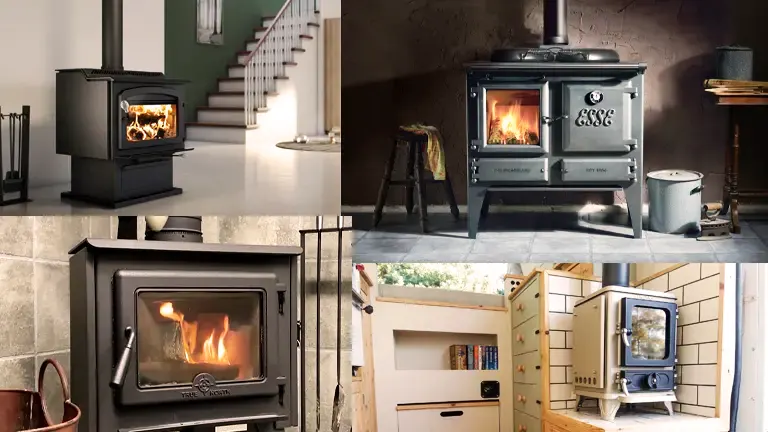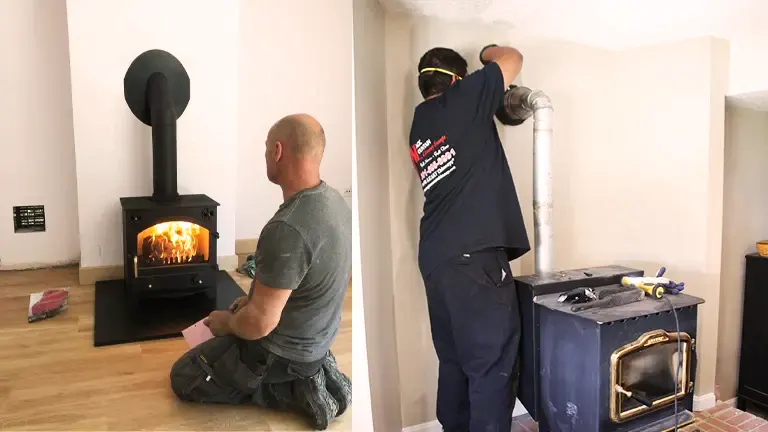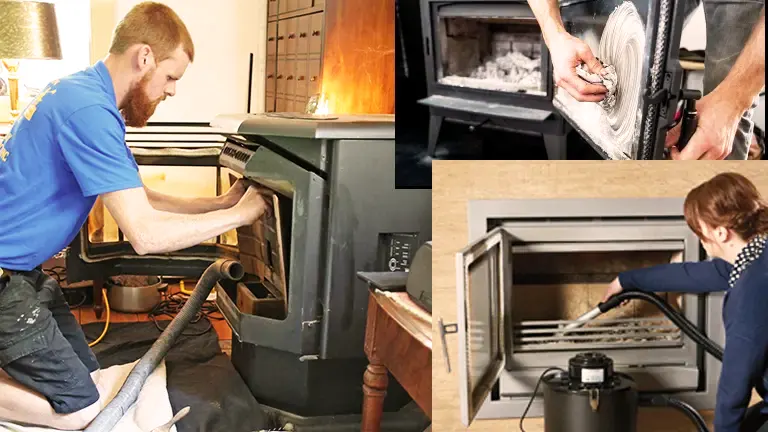Wood Stove Guide
- July 18, 2023
- 0 comment
Wood stoves have long been cherished for their warmth, charm, and cost-effective heating capabilities. Whether you’re considering a wood stove as a primary heat source or as a backup option during power outages, this comprehensive guide will provide you with all the essential information you need to make informed decisions throughout the process. From choosing the right stove to proper installation and maintenance, let’s dive into the world of wood stoves.
Choosing the Right Wood Stove

Consider the following factors when selecting a wood stove:
- Heating Needs: Determine the square footage you want to heat and assess the stove’s heat output capacity to ensure it matches your requirements.
- Design and Aesthetics: Wood stoves come in various styles, finishes, and sizes. Choose one that complements your home décor and personal preferences.
- Efficiency: Look for stoves with high-efficiency ratings to maximize heat output while minimizing fuel consumption.
- Emission Regulations: Check if the stove meets local emissions standards for a cleaner and eco-friendly burn.
- Additional Features: Consider features like air wash systems, ash drawers, and heat shields that enhance convenience and safety.
Operating a Wood Stove Effectively
To make the most of your wood stove, follow these steps for safe and efficient operation:
- Prep Your Stove: Ensure proper air supply by checking for indications or indicators in some models.
- Build the Fire Bed: Arrange firelighters, paper, and dry kindling wood on the fire bed. Ample kindling is essential for a successful fire; don’t underestimate its importance.
- Start the Fire: Wait for kindling to catch fire and start burning. Employ a log guard to contain burning materials and prevent contact with the glass.
- Slightly Open the Door: A slightly open door aids flue pull and fire lighting. It also prevents glass condensation. Note that in certain cases, keeping the door shut regulates airflow and accelerates ignition.
- Add Larger Pieces Gradually: Once the kindling burns well, introduce larger split wood pieces. Avoid adding full logs immediately; gradually build up the fire to prevent smothering.
- Monitor Airflow: Most wood stoves offer adjustable airflow. After the fire is steady, decrease airflow to slow wood consumption. Adjust only when the fire is established. As it intensifies, reduce air intake to ensure steady and efficient combustion. Watch closely, as altering airflow too early can extinguish the fire.
Installation Considerations

Proper installation is crucial for safe and efficient operation. Follow these guidelines:
- Clearances: Ensure adequate clearances are maintained between the stove, walls, and combustible materials as per the manufacturer’s recommendations.
- Ventilation: Install a proper chimney or flue system that meets building codes and provides sufficient draft for effective combustion.
- Floor Protection: Use non-combustible flooring or install a stove board to protect the floor from heat and sparks.
- Professional Installation: If you’re uncertain or unfamiliar with wood stove installations, it’s best to hire a professional for a safe and compliant setup.
Operation and Maintenance

To ensure optimal performance and longevity of your wood stove, follow these tips:
- Seasoned Firewood: Burn only well-seasoned hardwoods, as they provide maximum heat output and produce fewer creosote deposits.
- Proper Airflow: Learn how to control the stove’s airflow to maintain efficient combustion and prevent excessive smoke or insufficient heat.
- Regular Cleaning: Clean the stove and chimney regularly to remove creosote buildup and maintain proper ventilation.
- Safety Measures: Install smoke and carbon monoxide detectors, use a fireproof mat for ash disposal and keep a fire extinguisher nearby for added safety.
How to Maintain Wood Stove Glass Clarity
Concerns about excessive dirt on wood-burning stove glass are common, though mainly seen in older models less optimized for ease. Contemporary wood stoves are typically straightforward to clean. Many feature self-cleaning glass, eliminating the need for intense scrubbing. Even non-automated versions require minimal upkeep, ensuring hassle-free maintenance and optimal condition. A helpful trick involves utilizing stove ash for glass cleaning—apply damp ash using a cloth to efficiently remove soot buildup.
For exterior wood stove cleaning, avoid using damp or wet cloths to prevent metal rust. Instead, opt for a vacuum cleaner with a soft brush attachment to safely clean the outside surfaces.
Environmental Considerations
Use your wood stove responsibly to minimize environmental impact:
- Sustainable Wood Sourcing: Choose sustainably harvested firewood or consider using certified wood pellets as an eco-friendly alternative.
- Efficient Burning: Operate the stove properly to reduce emissions and maximize fuel efficiency.
- Carbon Neutrality: Consider offsetting your wood stove’s carbon emissions by planting trees or supporting reforestation projects.
Do Wood Burning Stoves Impact Health?
Wood-burning stoves do not pose significant health risks when operated and maintained correctly. While stove smoke contains pollutants that can lead to coughing and breathlessness, these effects are mitigated when a well-maintained chimney or flue is used.
Modern wood stoves are notably safer and more efficient than their older counterparts. For added peace of mind, replacing an older model with an efficient modern wood burner is recommended.
Regulations for Wood Burning Stoves
As of 2022, new regulations stipulate that new wood-burning stoves must limit carbon emissions to predefined levels. While existing log burners can continue operation, newer stoves must adhere to higher efficiency standards.
All wood-burning stoves must adhere to UK building regulations. Specifics include flue fitting, hearth size, and stove-to-combustibles distance. Consulting professional stove installers before purchase is essential due to property-specific requirements. Stoves must stand on non-combustible hearths extending at least 225mm forward and 150mm at the sides. If the hearth is on a combustible floor, it should be at least 250mm thick. Stoves with outputs of 5kWs or higher need a permanently open vent. Regulations may be more intricate for listed buildings.
Are Wood Burners Environmentally Friendly?
Wood-burning stoves offer a low-carbon heating alternative to fossil fuels. Trees absorb carbon dioxide, and burning their wood releases the absorbed carbon back into the atmosphere. Sustainable management ensures newly grown trees capture released carbon, creating a closed carbon cycle, and maintaining atmospheric carbon dioxide levels. Sourcing local or sustainable wood renders wood burners almost carbon neutral.
However, burning freshly chopped “green” wood isn’t ideal due to its high moisture content. Kiln-dried firewood with lower moisture content emits fewer smoke emissions, making it a cleaner fuel option.
Choosing the Right Size Stove
A stove’s size matters beyond aesthetics. Properly sizing a stove is crucial. An undersized stove won’t heat the area adequately, while an oversized one can overwhelm the space with heat. Seek guidance from seasoned professionals to select a wood-burning stove that suits your property’s dimensions.
Is it Feasible to Use Coal in a Wood Burning Stove?
Wood-burning stoves are exclusively designed for wood combustion, not coal. The design discrepancy lies in the fact that wood-burning stoves possess a flat plate, as wood requires air from above for burning. In contrast, coal necessitates a raised grate to allow both top airflow and ash evacuation to prevent accumulation.
While various types of wood can be used in your stove, it is essential to burn only seasoned wood—wood that’s been aged for at least a year and dried thoroughly.
Alternatively, multi-fuel stoves are available for those interested in burning both coal and wood. These stoves offer flexibility in fuel choice. Coal can provide prolonged heat and convenient storage, yet concerns about its environmental impact and extraction often arise. On the other hand, wood requires proper storage to avoid moisture damage.
Can a Wood Burning Stove Heat the Entire House?
In certain scenarios, it’s indeed possible. The performance of your wood burner depends on its type. A wood-burning stove with a back boiler can efficiently heat an entire property. The back boiler system utilizes fire-generated heat to warm water, which is then circulated through a central heating system. This mechanism ranges from using a hot water tank to integrating with traditional boilers. Stoves can distribute heat more extensively throughout the house compared to open fire.
Is a Chimney Essential for a Wood Burning Stove?
While it is feasible to install a wood-burning stove without a chimney, this endeavor requires additional precautions to ensure safety. A flue system, often known as a twin wall flue, can be installed in your property to accommodate the stove. This versatile system is cost-effective and can be positioned either through the roof or externally, contingent on several factors. Consequently, having a wood burner sans chimney is attainable through proper installation.
Conclusion
We’re eager to hear from you! Kindly share your personal experiences and thoughts about your wood stove journey in the comments section below. Your valuable insights have the potential to guide and assist fellow enthusiasts in making well-informed choices when it comes to selecting and utilizing wood stoves.
We’re eager to hear from you! Kindly share your personal experiences and thoughts about your wood stove journey in the comments section below. Your valuable insights have the potential to guide and assist fellow enthusiasts in making well-informed choices when it comes to selecting and utilizing wood stoves.

John Carlos
Forestry AuthorThe beauty of logging isn't just about felling trees. It's about understanding nature, mastering the art of chainsaws, and respecting the environment. I believe in sharing my experiences and knowledge, ensuring that we move towards a sustainable future together.













Leave your comment